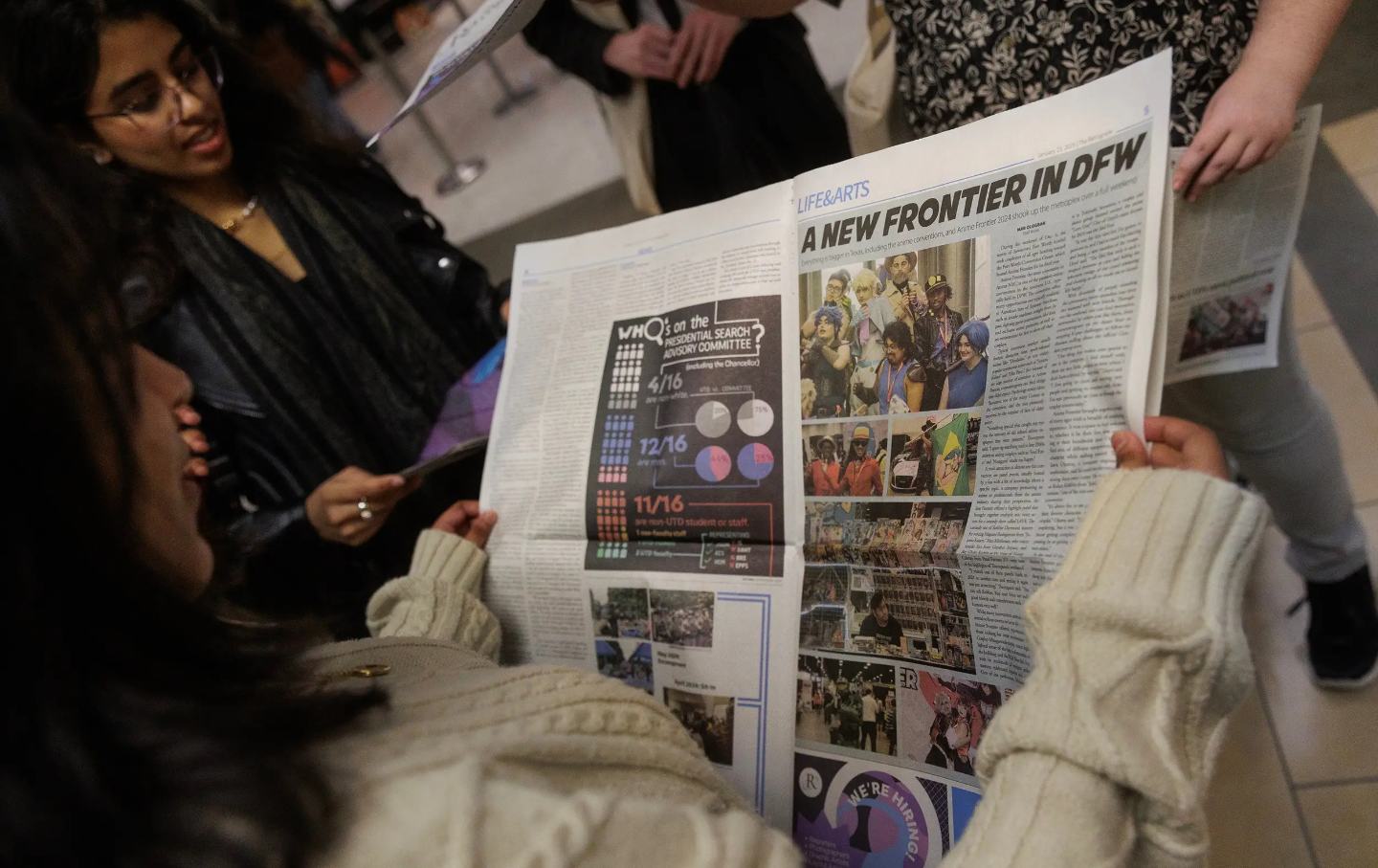The Labor Crisis Putting People With Disabilities at Risk
The workers who care for people with disabilities are underpaid, overwhelmed, and increasingly leaving the field. Advocates say action is desperately needed to stem the tide.

Disability advocates rally at the New York State Capitol in Albany, New York, on February 14. 2024.
(YouTube)On a crisp morning in April, Ed Bartz lay awake in his bed in Troy, New York. According to his digital alarm clock, which had been carefully positioned to stand in his line of vision, he’d been like this for an hour—awake, aware, worried.
But Ed couldn’t do anything about it. He was born with cerebral palsy, and at 61, his impairments had grown worse. “I am basically a head without a working body,” he told me. At around 11 each night, somebody from The Arc of Rensselaer County, a disability service organization, helped him settle in for sleep; at eight each morning, someone else came to pull up the blinds. Today, that person was supposed to be Yazlin. She would lift him into the shower, bathe him, pull fresh clothes over his body, get him into his motorized chair, set up his assistive technology, and make breakfast.
But Yazlin hadn’t shown up when she usually did. Ed’s heart beat hard. Had she been in an accident?
As it turned out, Yazlin was simply running late. “When they get here I immediately ask if everything in their life is OK,” Ed explained later, by e-mail. (He can move his head enough to type, slowly, by wearing a reflective sensor on his forehead that acts as a mouse, and using this on his communication device, a keyboard technology that generates speech.) “I get angry because my morning is wasting away while I’m waiting for help, but showing this anger is fruitless. I need HELP! But getting angry doesn’t help anybody.” Although Ed sometimes experiences this two or three times in one week, the feeling of panic never quite goes away. Several times, no one has shown up at all.
“Most of the time I think very little about my disability,” Ed said, “but when people don’t show up when expected, it slaps me in the face how reliant I am on others. I form bonds with the people who help me. When people don’t show up, I begin to feel like I’m just a job.”
Yazlin is a direct support provider, or DSP. DSPs provide crucial care for people with intellectual and developmental disabilities—a population that tops 8.3 million nationwide—often fulfilling many roles at once, such as nurse, dietician, occupational therapist, chauffeur, personal trainer, and job coach. At the same time, they must perform basic caretaking functions, like helping with medicine, grocery shopping, cooking, and personal care and hygiene.
“Their work is highly complex and goes well beyond caregiving,” said Joseph Macbeth, the president and CEO of the National Alliance for Direct Support Professionals (NADSP). And a DSP supports several people at once, across many settings—residential group homes, community job sites, vocational and day programs. They form highly individualized relationships that take time to foster and finesse. Ed describes these relationships as “very personal”: “How could they not be? They are helping me with very personal aspects of my life.”
Yet the median hourly wage of a DSP is just $15.98 (and this is expected to decrease when funding from the American Rescue Plan Act expires in March 2025). As a result, the workforce is chronically understaffed and overworked, straining to provide round-the-clock care for people whose lives depend on it—and inevitably falling short. The profession has been in “crisis” since its very beginning in the 1970s, says Macbeth—and suffers most during a strong economy, when people can find better paying jobs (with less accountability) outside the caregiving workforce.
Currently, 90 percent of agencies that employ DSPs nationwide report “moderate” or “severe” staffing shortages, and as a result, 69 percent experience difficulty meeting established quality standards (as set at the agency level, because there is no federal set of quality measures to date). In 2023, the average turnover ratio for DSPs was 40 percent, with 87 percent of DSPs staying on the job for fewer than 36 months. The vacancy rate for full-time positions was as high as 18 percent.
And because of such ongoing shortages, in the past year, nearly three-quarters of respondents had to turn away new referrals. In 2024, over half a million people with intellectual and developmental disabilities were on their state’s waiting list to receive services, with nowhere to go. Usually this means remaining in family homes, with no support beyond cobbling together care from private networks. Others—who may not have family, or who have needs that the family is unable to support—often wind up in hospitals, psychiatric centers, or homeless shelters.
Covid-19 exacerbated this staffing crisis. But even now, several years later, trends have not returned to pre-pandemic levels. In 2024, more than one-third of agencies nationwide said they would need to consider additional service cuts if high turnover and vacancy rates among DSPs continued. For many, activities beyond basic caregiving have hardly resumed—because in disability care, safety must come first.
“Nobody is neglected or ignored,” one mother, Marion Resnick, told me. Her 44-year-old son Jeffrey has Down syndrome and lives in a group home in Brooklyn. She praised his caregivers for working tirelessly, but added, “All the things that make a life a life are not getting done.” Jeffrey is very social; he works at Marshalls, and loves going bowling and to the movies. When his group home first opened in 2012, there had been more staff, and they’d been able to do those things together. But now, his mother explained, “casual activities”—bowling and the movies—“don’t exist anymore, unless we take him.”
One advocacy group, New York Alliance for Inclusion and Innovation, has been organizing to address the staffing crisis since at least the 1990s. A typical example of this crisis, NY Alliance’s president and CEO Michael Seereiter told me, concerns bathing routines at group homes: lining up the residents each evening for showers, even if one of them prefers a morning shower or doesn’t want to wait in line. There are just not enough people to give any more-personal care.
“This is not a locker room! This is their own home,” Seereiter said, observing how this one small example represents the staffing crisis writ large. “We drive out personalization. We drive out any of the individual choice because there’s not enough staff to provide the support.”
“So you see this very slow erosion of the quality of services, and frankly the quality of life,” he continued. “And so that’s how it goes. There’s a lot of history packed into this.”
Until the 1970s, institutions represented the primary form of professional care in the United States for people with disabilities. Doctors would advise parents of infants diagnosed with severe disabilities to send them to institutions, to avoid becoming “an emotional drain” on their parents and exerting a “psychologically damaging influence” on their siblings, according to historians David and Sheila Rothman in their book The Willowbrook Wars: Bringing the Mentally Disabled into the Community.
This thinking began to change in the mid-1950s, when the development of antipsychotic medication kick-started the move to deinstitutionalize mental health and disability care. This was a highly interrelated process that targeted mental health and disability facilities, respectively. Legislation like the Community Mental Health Act (also known as the Mental Retardation and Community Mental Health Centers Construction Act) of 1963 provided state grants to move people out of institutions and into residential care facilities with fewer than 16 beds. The people who worked at these early community-based programs represented the first generation of direct support staff.
Public institutions housing people with a range of intellectual disabilities, including conditions now called autism, Down syndrome, cerebral palsy, and Fragile X syndrome, reached their peak occupancy in 1967, with a nationwide population of nearly 200,000; another 30,000 labeled, in the offensive language of the era, as “retarded,” were in psychiatric facilities. This number has decreased steadily ever since, fueled by litigation that condemned institutions for abuse. The most famous example is the Willowbrook State School on Staten Island, where a 1972 class action lawsuit brought by the parents of Willowbrook residents shifted the care model away from mere “custody” and toward “rehabilitation.”
Popular
“swipe left below to view more authors”Swipe →The ensuing deinstitutionalization recognized the capabilities of people with disabilities and sought to provide community-based supports, like group homes and day programs, so that they could participate in public life. The 1970s was also when “self-advocates” began organizing and gaining recognition as intellectually and developmentally disabled people who wanted to make their own choices. This is when DSPs emerged as the primary form of care for people with disabilities.
Jerry Smith, the director of marketing and communications at the University of Minnesota’s Institute on Community Integration, explained that at institutions, staff had functioned mainly as custodial caregivers, providing a basic level of health and safety and not much else; there wasn’t yet a commitment to education, to civil rights, to advocacy. Therefore, an “idealism” set DSPs apart from their predecessors: “Many of these people saw their work as being part of a civil rights movement for people with disabilities.”
This emerging model had its gaps—as the Harvard Kennedy School’s Alex Green, a scholar on the history of disability institutions in America, cautions, the nondisabled insistence on “caring for” people with disabilities can come “at the expense of supporting the full-throated ambitions for equality that self-advocates were demanding.” But still, he said, what came before was “something akin to a death camp,” and DSPs helped change the paradigm. “At their best, DSPs became fierce allies of disabled people as they fought against often-hostile communities for the equality they’d previously been denied, and that’s true to this day.”
High turnover and vacancies have plagued the workforce since the beginning. “We willingly planned and implemented community supports with staff who were being paid less, who had access to less stability, fewer benefits,” said Amy Hewitt, director of the UMN Institute on Community Integration, in Invaluable, a documentary about DSPs that the institute produced. “We did that because of a good thing: We wanted people with disabilities to live in the community. But the way we could afford that was on the backs of the worker, and we’ve never caught up.”
Smith and others observe that, although all caregiving work is important and undervalued, DSPs differ from home health aides in their invisibility. And low compensation for such high-demand labor can be demoralizing.
Some DSPs, like Fatimah Howard, said that low wages connote a lack of respect for DSPs and the populations they serve. “Even though staff does so much work, all day, it’s looked on like it’s small—like it’s babysitting,” she said. “Unless you walk in their shoes, you don’t know, you don’t understand.”
Fatimah is a DSP in New York City, often helping to support six or seven people with complex developmental disabilities at once, taking them out into the community so that they can learn and practice job skills—volunteering at a soup kitchen, for example. She said she came to the job by chance, in 2022, and completely fell in love with the work. “It’s the best thing I could’ve done.” Now, Fatimah is 26 years old and the mother of three young children; she gets paid around $1,300 every two weeks, and until recently worked another part-time job to support her family.
“This job is not for the income; it’s for the passion,” she said. “It’s not the money that’s going to make you happy.” Although Fatimah was candid about facing burnout recently, she said that a short vacation helped her recover, and she has no plans of leaving the field.
“It’s sad,” she added, “because a lot of staff leave because of the pay, and then the people being supported have gotten attached to their staff, and everyone comes and goes…and they need a steady environment in which to learn. It’s like starting from the beginning.”
Despite the bleak state of the DSP workforce, there has never been more need. People are living longer lives, and as the older adult population grows, so must the home care workforce, which is expected to increase by 26 percent bby 2032. This would add over 861,000 new jobs for a projected 5.8 million total openings in home care —“more new jobs than any other single occupation in the country,” according to PHI, a national nonprofit that researches and advocates for the direct care workforce. But whether there will be enough people to fill those jobs is improbable.
Research and advocacy organizations have been hard at work on initiatives that could attract and retain more DSPs by addressing the root problem—low wages—through a variety of measures to “professionalize” the job. In New York, the Office for Persons with Developmental Disabilities (OPWDD), along with partners like the New York Alliance for Inclusion and Innovation, are investing money to attract talented DSPs by offering training and certification programs at the high school level. One of the main goals is to “build a pipeline of DSPs coming out of the education system,” Seereiter said. OPWDD is also contracting with NADSP to pilot a credential program for DSPs, which could lead to additional pay opportunities that correspond with and incentivize professional development.
Although a higher minimum wage would theoretically solve some of these problems, there is not a “minimum wage” in the DSP system because providers must abide by whatever minimum-wage standards exist in their state; beyond that, what they can afford to pay is determined by the state Medicaid agency, which, in turn, requires states to appropriate adequate funding. Likewise, unionization generally isn’t a solution, because it’s hard to bargain with organizations that don’t set their own rates. Unions would need to advocate for more Medicaid funding, which isn’t exactly the business they’re in.
And so credential programs and other creative solutions are cropping up across the country. This month, Pennsylvania’s Office for Developmental Programs is launching a model that incentivizes employers to get DSPs certified through NADSP’s E-Badge Academy. Last year, California launched a DSP Internship Program, and this year will pilot a training and certification curriculum dubbed “DSP University” that will explore wage differentials.
In the meantime, the staffing crisis continues. Samantha Klopman was Ed Bartz’s DSP, but when she moved away from New York in May of 2023, she left the field altogether. “I was inspired to be a DSP because I wanted to do something meaningful,” she reflected, having grown up with a mother who was a nurse. “In 2017 and 2018, I worked as an activities aide in a nursing home and I loved it. I switched to working as a DSP directly after.” But the low pay eventually wore her down, and she switched careers after four years.
Ed’s job is advocating for disability rights—which, he says, entails offering training to DSPs and advocating for workers’ rights. His days are fully booked with advocacy commitments: talking to state government and working at the NY Alliance as a consultant. Ed and I met by Zoom over the course of months. Between February and April, his assistive communication device was broken, and it took weeks for a doctor, care coordinator, and physical therapist to rubber-stamp that it was indeed broken, and weeks more for a new one to arrive.
“I wait a lot lately,” Ed told me, adding, “On a daily basis, I am a happy person.” But when he gets neglected—when he gets stranded in bed—he views this as a call to action.








